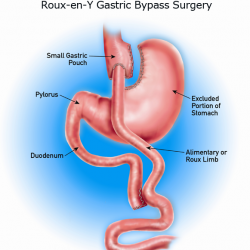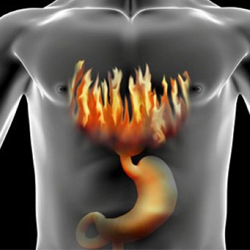
Bypass Gástrico en Y de Roux
The gastric bypass surgery
The Roux-en-Y gastric bypass surgery, also known as RNY gastric bypass, or simply gastric bypass, is currently considered the gold standard of bariatric surgery in the United States. It is the most commonly performed bariatric operation in America. It is considered by most experts as the most successful weight loss operation.
The gastric bypass surgery is currently considered the gold standard of bariatric surgery in the United State and is considered by most experts as the most successful weight loss operation.
The gastric bypass surgery is particularly recommended in people who:
- continuously eat small portions of food
- eat lots of sweets
- have diabetes or metabolic syndrome
- have severe esophageal reflux disease including esophagitis
- have a BMI greater than 50 kg/m2
The gastric bypass surgery consists of a combination of restriction and malabsorption. Meaning, after surgery, you will be able to eat only small portions of food. You will feel full for a long time with very little food. In addition, most of what you eat will not be absorbed by the intestine.
The gastric bypass surgery consists of a combination of restriction and malabsorption.
Restriction is achieved by dividing the stomach in two parts, a very small one connected to the esophagus (the food pipe that connects the mouth with the stomach) and another large one connected to the duodenum (the first portion of the small bowel). Malabsorption is achieved by dividing the small bowel and connecting it to the small portion of the stomach. The large portion of the stomach is left in place because it provides gastric acid, hormones, and enzymes required for a normal digestion.
Therefore, small amounts of food will make you full. Food goes directly into the second half of the small bowel; this is why the operation is called the gastric bypass, because food never reaches the stomach or the duodenum.
Food goes directly into the second half of the small bowel; this is why the operation is called the gastric bypass, because food never reaches the stomach or the duodenum.
Laparoscopic and open gastric bypass surgery
The gastric bypass can be completed either through laparoscopic technique or open conventional surgery. All patients are given blood thinners and IV antibiotics before surgery. Additionally, you will have compressive stockings and an intermittent compressive device in your legs until you are completely recovered.
The laparoscopic gastric bypass surgery technique involves 5 small incisions through which a camera and small instruments are introduced into the abdomen. The entire surgery takes about 2 ½ hours. It requires general anesthesia.
The open Roux-en-Y gastric bypass surgery is reserved for patients in whom laparoscopic surgery is not indicated, in super obese patients, and for conversion of failed or complicated bariatric operations to Roux-en-Y gastric bypass. It is done through an incision that goes from your sternum up to your belly button with the same instruments and staplers used in laparoscopic operations. The operation also requires general anesthesia. However, the operation can be completed as fast as one hour.
Recovery after gastric bypass surgery
Regardless of the technique used to complete the gastric bypass, you will be able to get out of bed the night of the operation. However, you will be kept without eating or drinking water for 48 hours. All medications and liquids will be given through the IV. After this period, you will have an esophagogram. This test consists of drinking a small amount of contrast material that will paint your operation in an X-Ray. This is done to verify that there are no leaks in your connection between the new stomach and the small bowel. Once we confirm that you have a normal test you will be able to drink water. You will be kept in the hospital for an additional 24 hours to make sure there are no problems drinking liquids and you will be discharged to your hotel with the diet recommended by the dietitian. You will be back to your routine physical activities on an average of 8 to 10 days following surgery.
Diet following gastric bypass surgery
After your gastric bypass surgery you will have a strict follow-up with the dietitian. Once you restart your diet 48 hours after your operation, you will only be able to drink water. The next day you will be started on a full liquid diet including protein supplements and liquid vitamins. You will have this diet for at least two weeks. You will then be advanced to pureed diet for the following month. Depending on your progress, solid food will be reintroduced around 6 to 8 weeks following surgery. Iron, calcium, protein, and certain vitamins will be supplemented routinely to avoid any nutritional deficiencies.
Our experience
Dr. Rodrigo Gonzalez is one of the very few surgeons practicing in Latin America who completed a supervised one-year fellowship program at a University-affiliated hospital in the United States. His training involved the evaluation and preparation of clinically significant obese patients for weight-loss surgery. During his training he personally performed over 400 operations open and laparoscopic Rou-en-Y gastric bypass operations. He also received training in converting failed or complicated weight loss operations to Roux-en-Y gastric bypass.
During his training, Dr. Rodrigo Gonzalez acquired sufficient experience and knowledge to be able to manage and treat patients with morbid obesity and to perform these operations here in the United States and any other country in the world.
Dr. Rodrigo Gonzalez is one of very few surgeons practicing in Latin America who completed a supervised one-year fellowship program at a University-affiliated hospital in the United States.
Since his return to Guatemala, Dr. Rodrigo Gonzalez has dedicated most of his practice to bariatric surgery and has done well over hundreds of bariatric operations including Roux-en-Y gastric bypass, gastric banding, sleeve vertical gastrectomy, and revision of complicated or failed weight-loss operations to Roux-en-Y gastric bypass.
Dr. Rodrigo Gonzalez dedicated a significant amount of his time to study and research the field of Bariatrics. He has published over 25 papers in the most prestigious medical international journals and has been asked to write chapters for 5 books published in the United States and Great Britain. He has also been invited to publish review articles in renowned medical journals. (For a complete view of Dr. Gonzalez’s CV please click here). He is considered by the international medical community as an expert in bariatric surgery and is therefore frequently asked to give talks in bariatric courses and meetings in order to present his experience in weight-loss surgery.




